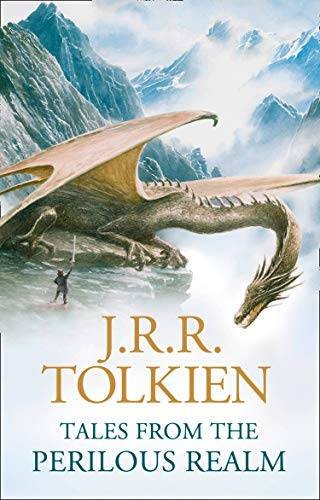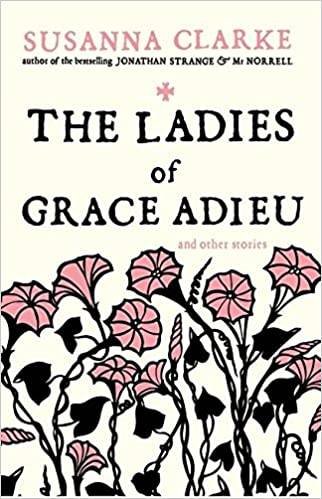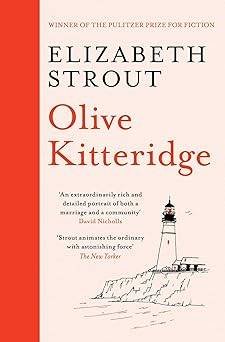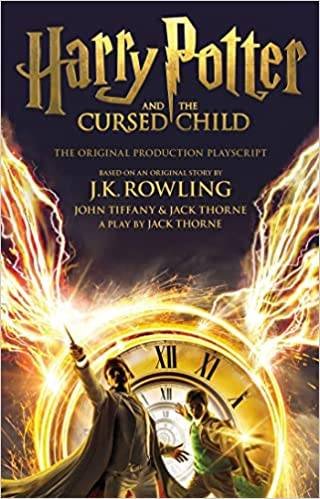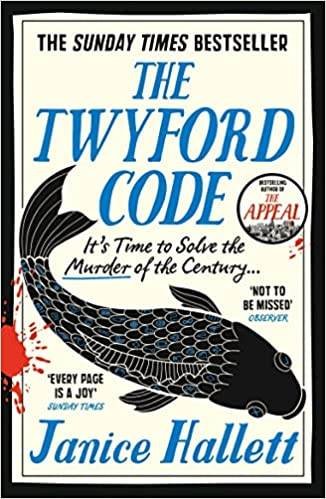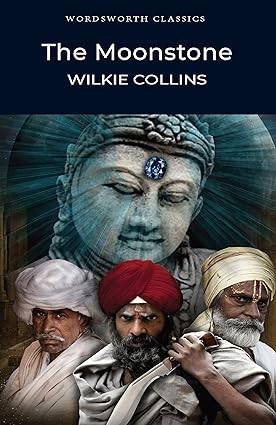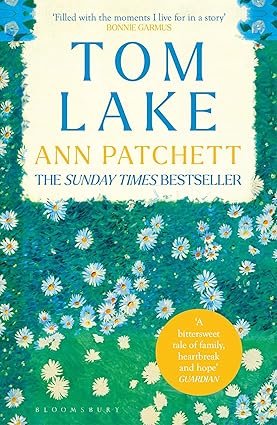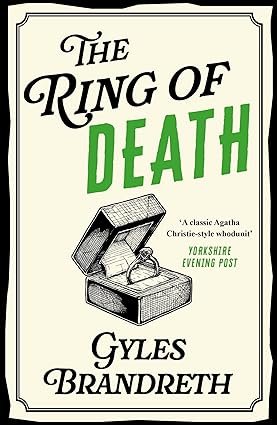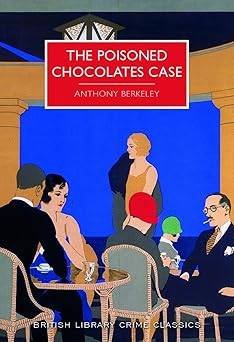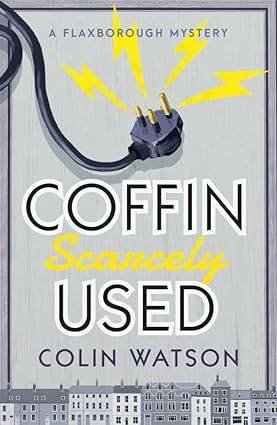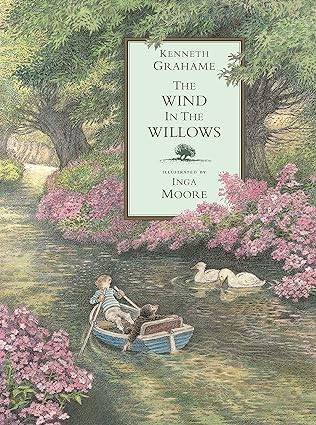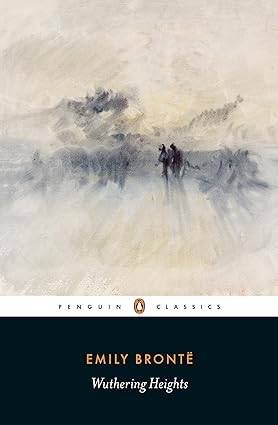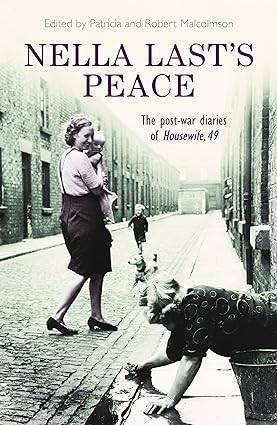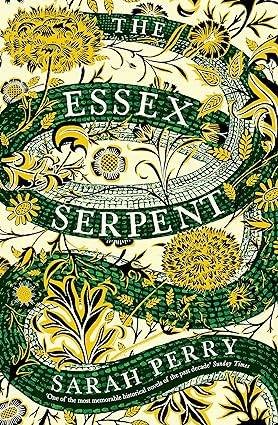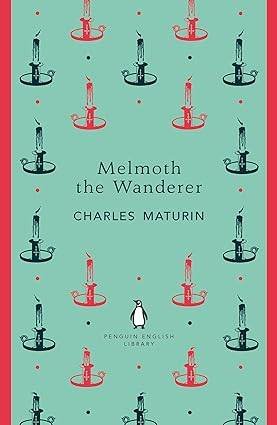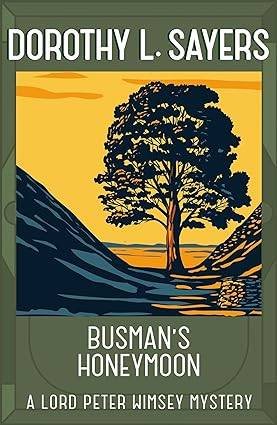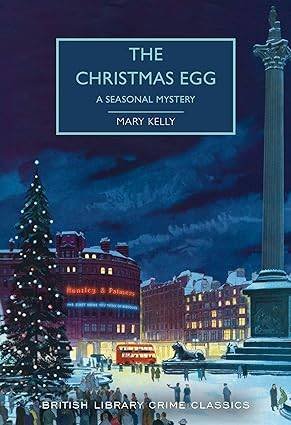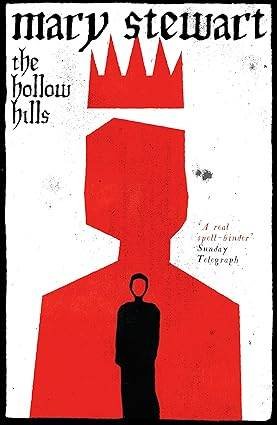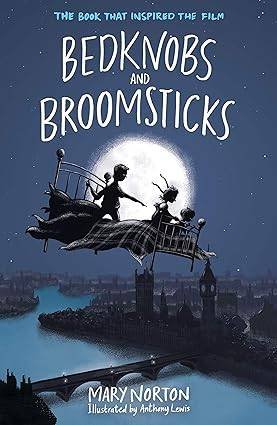Home » Book Reviews » JRR Tolkien » Tales from the Perilous Realm by JRR Tolkien
Possible spoilers ahead
I love the Lord of the Rings series of books, so was excited to see this book with its set of five tales. I am hoping it will be a kind of child’s version of the Lord of the Rings stories with my favourite characters yet with none of the danger (!), or perhaps a kind of extension of the Lord of the Rings stories with more explanations of the characters.
The first tale is Roverandom. Rover the dog is transformed into a toy dog and sent to a toyshop by Artaxerxes (a wizard from Persia and Pershore) because he bit Artaxerxes’ trousers. Rover (as a toy dog) is taken home by Little Boy Two but is then lost at the seaside. He is found by Psamathos Psamathides (a sand sorcerer/wizard) who performs magic to enable Rover to move again but can’t return him to his original size. Mew the Postman Seagull is asked to take Rover to the Man-in-the-Moon, so they travel along the moon’s path at 1000 miles a minute and fly over the Isle of Dogs and pass the edge of the world where waterfalls drop into space. The Man-in-the-Moon lives in a white tower at the top of the tallest mountain on the moon, and he has a flying moon-dog who is also called Rover, so toy dog Rover is now called Roverandom in order to distinguish them and he is also given wings. Rover explains that he used to rove all over the world but then fell over the world’s edge chasing a butterfly, however the moon was passing underneath at the time so he landed on that but fell into an enormous silver net that the giant grey spiders on the moon had spun, he was then rescued by the Man-in-the-Moon who gave Rover wings. Rover shares with Roverandom the advice which was given to him by the Man-in-the-Moon, which was ‘Don’t worry the moonbeams, and don’t kill my white rabbits, and come home when you are hungry, the window on the roof is usually open’. Omg, I am just in awe of the imaginative details in this story, it just charms me completely! And I especially love the advice from the Man-in-the-Moon which Rover shares, it’s a lovely mix of caution but with the stuff of dreams, with moonbeams and white rabbits along with the acknowledgment that dogs are always hungry! If I had a dog, I think I’d copy that out and put it above the dog’s basket! I think I’d also have to call my dog Rover! Which makes me wonder if the popularity of Rover as a dog’s name was due to this tale, or if Tolkien chose the name Rover because it was so popular at that time? And I also realise I don’t often hear Rover as a dog’s name so often now, which is a shame. I loved the description of Psamathos Psamathides’ legs being like rabbit’s legs, such wonderful imagination! And the unusual name of Psamathos Psamathides and him being a sand sorcerer reminds me of a book I’ve been meaning to read, which is The Five Children And It by E Nesbit, as the blurb on the back of this book states that it features a sand fairy called Psammead (do magical people who are connected with sand have to have their name beginning with Ps, I wonder?!). And I adored Mew the Postman Seagull, what a wonderful idea, I can just imagine seagulls being perfect as postmen! I also loved the thought that lost dogs go to the Isle of Dogs, where there are also bone trees! I was intrigued by the edge of the world being near Gwynfa, as I wondered if this was supposed to signify that it was in Wales (and, omg, I’ve just googled the word ‘Gwynfa’ and it is apparently the Welsh word for paradise! I love it!). And I adore Rover the moon-dog too and that he was chasing a butterfly and fell over the world’s edge, tee hee! But eeek, the giant grey spiders on the moon sound a little alarming! I just love this story altogether so far and I am so envious of Tolkien’s children and grandchildren likely being told such wonderful bedtime stories like this by him!
The dogs and the Man-in-the-Moon live on the white side of the moon, where the scenery is pale with a dark sky. There are large fierce insects to avoid there, such as dragon-moths and sword-flies and glass-beetles (who have jaws) and unicornets (who have stings) and shadowbats, as well as 57 varieties of spiders and the dogs often bite through the webs in order to set free the moonbeams. The flowers and grasses make music. There are also birds there, but these are usually silent and very tiny and many have forgotten how to fly or lost their wings, they hunt little white mice and grey squirrels. There are also white moon-gnomes, also called moonums, who ride on rabbits and grow apple trees the size of buttercups in their orchards. There are also tiny sheep with golden bells, and an enormous white elephant. There are also dragons there, particularly the Great White Dragon who chases the dogs, and who has been down to the world before and fought with the Red Dragon in Merlin and King Arthur’s time. It snows there, but the snow is nice and warm and turns into sand which blows away. Eeek, I’m a bit daunted by the huge amount of spiders there on the white side of the moon, but I love the idea of the dogs biting through the webs in order to free the moonbeams, such a lovely idea! I also love the range of insects too, although they don’t sound friendly, especially the unicornets (but what a great name they have!). And I’m completely charmed by the flowers and grass being able to make music! But I think the moon-gnomes must be my favourite, riding on rabbits and growing apple trees the size of buttercups, I just love it! I wish there was a Tolkien book just about all these creatures, perhaps a tale about each one which then made up a wonderful set like the Beatrix Potter series of animal tales, it would be wonderful! And I was excited that dragons were mentioned and particularly the red and white dragons, as I remember the story that these were fighting underneath a castle and causing it to continually fall down, until Merlin realised the cause and dealt with them.
The Man-in-the-Moon takes Roverandom to visit the dark side of the moon, which is reached via his cellar in the tower, then down secret spiral steps under the mountains to a door in the floor which opens onto the black space in the middle of the moon, and then a traveller uses the wind to fly to the other edge of the black space and to the dark side of the moon. The dark side of the moon has dark scenery with a pale sky and is wet, there are grey mountains and dark valleys and dark hills and black clouds, and lingering there are half-forgotten things and confused memories and paths. There are also black spiders, which aren’t as large as the spiders on the white side on the moon but are poisonous, and birds who sing songs that send a listener to sleep, as well as tiny fireflies and diamond-beetles, and ruby-moths who are hunted by huge eagle-sized owls and vulture-sized crows, and black-velvet bob-owlers who fly in groups in the clouds, as well as shadowy rabbits, and pine trees. No-one has ever seen the dark side of the moon whilst awake. Children go there while asleep in their beds on the world, they dance and walk and run in a valley there with grey fountains and long lawns, digging and gathering flowers and building tents and houses and chasing butterflies and kicking balls and climbing trees and singing, and there are hidden sentinels who keep the children safe in this valley which has a cliff of jet around it that the spiders can’t climb over to get into the valley. The Man-in-the-Moon and Roverandom toboggan down the cliff of jet into the valley. The Man-in-the-Moon makes dreams for the children who visit the valley, though he says some children also bring dreams with them. The Man-in-the-Moon often throws the children up in the air but they don’t fall down again so he gives them a silver rope to climb back down. Little Boy Two is there in the valley and recognises Roverandom, who tells the boy all about his adventures and they play together, and the boy reminds Roverandom that he still belongs to him, but then the boy vanishes as he has woken up back on the world. Oh wow, I am just blown away by the imagination of this author, the descriptions of this dark side of the moon is just amazing, whilst being a mix of slightly scary with the poisonous spiders and the other creatures, and comforting as the dreaming children are safe in the valley, and I love them not falling back down when they are in the air and needing a silver rope to climb back down, as you often don’t seem to fall when you’re dreaming. And again, I love all the different creatures, especially the black-velvet bob-owlers, what a wonderful name!
The Man-in-the-Moon lets Roverandom look at Little Boy Two on the world through a telescope, and Roverandom tells the Man-in-the-Moon that he wants to go back to the boy, which the Man-in-the-Moon says is now possible because Artaxerxes has married a mermaid and gone to live in the sea. Mew the Postman Seagull takes Roverandom back to the world, and Rover the moon-dog promises to come and visit him there later. Roverandom goes to Psamathos Psamathides who tries again to restore him to his normal size but can’t override Artaxerxes’ magic, so advises Roverandom to go to Artaxerxes and beg his pardon. Roverandom is taken down to the bottom of the sea in a whale’s mouth, this whale is Uin who is the oldest of the Right Whales. The bottom of the sea is green, and a path of white sand winds through a forest and leads to a palace with sea-trees growing beside it and the fish swim in the branches. There are mer-people and sea-goblins and sea-fairies there. Artaxerxes lives in the palace, and is now the Pacific and Atlantic Magician and is married to the mer-king’s daughter, Princess Pam, who has a white mer-dog called Rover with webbed feet and a flat tail. She tells Roverandom, ‘Don’t worry the fire-fish, don’t chew the sea-anemones, don’t get caught in the clams, and come back to supper’, and Roverandom is given a fishy tail and webbed feet so he can swim. Artaxerxes is trying to control the Sea-Serpent who causes huge disturbances and chaos at the bottom of the sea and Roverandom tries to help Artaxerxes with this, but they are unsuccessful and the Sea-Serpent only promises to stop his destruction if Artaxerxes is sent away. The mer-people agree to this deal so Artaxerxes and his wife and Roverandom leave on the whale. When they reach the shore, Roverandom asks Artaxerxes to restore him to his original size, and Artaxerxes agrees. Roverandom walks home and is greeted there by Little Boy Two. Artaxerxes retires as a wizard, and sets up a cigarette and chocolate shop by the beach. Oh wow, this section is nearly as charming as the moon section, and I love how several of the themes are repeated but altered slightly, such as the range of creatures there, and with Artaxerxes’ wife’s advice to Roverandom (which I would have to now add to the sign above my imaginary dog’s bed, tee hee!), and there being another dog called Rover, this time a mer-dog, I love these tales of dogs! And I did chuckle at Artaxerxes’ cigarette and chocolate shop as they seem odd products to put together! It’s all just so adorable, I just love this story altogether, I think it is one I will read over and over again.
Farmer Giles of Ham is the second tale in the book. Aegidius Ahenobarbus Julius Agricola de Hammo is Farmer Giles, he lives in Ham which is a village in Little Kingdom, and has a talking dog called Garm. A giant comes to the area and Farmer Giles gets rid of it, though more by chance rather than by bravery or skill, and the king rewards Farmer Giles with a sword called Caudimordax or Tailbiter. This sword belonged to the greatest dragon fighter of all time, called Bellomarius, and the sword leaps out of its sheath when a dragon is nearby. Meanwhile, the expelled giant tells the dragons near his home about the plentiful lands in Little Kingdom, and one dragon called Chrysophylax Dives The Rich, decides to go there himself. Farmer Giles is ordered to get rid of this dragon and, although he doubts his ability and has no plan of how to do this, he has to obey the orders. However his sword leaps of its own accord and strikes the dragon, and the dragon recognises the sword and is then submissive to Farmer Giles who orders him to give up his riches and bring these back to Ham, which the dragon does and then lives at Ham as a tame dragon for some time before being allowed by Farmer Giles to go home again. Farmer Giles becomes known as Lord of the Tame Worm, which then caused the places in that area to be named in relation to this, so the modern-day village of Thame near Aylesbury is a mix of the names of Lord of Tame and the Lord of Ham, and the modern-day village of Worminghall is named from the house that Farmer Giles built. Tee hee, I love love love this fiction that modern-day place names were so named due to this story, that’s fantastic, and I immediately want to visit Thame and Worminghall! I’ve just looked on Wikipedia and the village of Thame looks like a lovely place with beautiful buildings and I see that many episodes of Midsomer Murders were filmed there (!), and Worminghall also looks a very pretty place too, so both would definitely be worth a visit. Apart from my fascination with these place names and the cheekiness of Tolkien to suggest they were named because of the events in his story, I didn’t find this such an involving tale as Roverandom with its wonderful details about different worlds and creatures, but this tale had some outstanding character names which I very much admired, especially Farmer Giles’ full name of Aegidius Ahenobarbus Julius Agricola de Hammo, and the dragon being named Chrysophylax Dives The Rich, wow! It is stated that the story was set before the time of King Arthur and I enjoyed the King Arthur elements in it with the sword.
The next tale is The Adventures of Tom Bombadil, and I especially loved Tom from The Fellowship of the Ring with his relationship with the trees and nature, he was one of my favourite characters from that book and I always wished he had featured more, so I was very excited to see that one of the stories in this book featured him. However, I was a little disappointed to find this chapter is just poems rather than a story. I’m sure these are wonderfully written poems, but I somehow have never really clicked with poetry and felt that I didn’t ‘get’ these poems either, which was a shame, I’d have much preferred if they had been stories. I did like the introduction to the poems however, where it states that Bilbo wrote quite a few of the poems, and Sam Gangee some others, and it feels very special to see their names in this book! There were several lines in the first poem (entitled The Adventures of Tom Bombadil, although all the 16 poems come under this main chapter heading) that I particularly liked, especially the description of Tom ‘tickling the bumblebees that buzzed among the flowers’, and ‘sitting by the waterside for hours and hours’, and that he ‘snored like a bellows’ and ‘whistled like a starling’, and the descriptions of nature are beautiful too such as Tom seeing ‘waking stars come winking, and the new slender moon early westward sinking’. I also liked the badger being called Badger-brock too (which reminds me of one of my favourite Beatrix Potter stories featuring Tommy Brock and Mr Tod) and his ‘snowy forehead and his dark blinking eyes’. The second poem is called Bombadil Goes Boating (the other poems don’t seem to feature Tom as much as these two first poems do) and it reminded me of Rat boating down his river in The Wind in the Willows, particularly with Tom teasing the birds like Rat teased the ducks. The third poem (entitled Errantry) has the words ‘he battled with the Dumbledors, the Hummerhorns, and Honeybees’ and I admit I let out a squeal to see the word ‘Dumbledors’ with the association in my mind of Dumbledore from Harry Potter! When I google to find out what Dumbledors are, the wonderfully trusty Wikipedia says ‘Dumbledor is an English dialect word for bumblebee’ (and that Hummerhorn was apparently a name invented by Tolkien for a large wasp or hornet). So now I’m intrigued if that was Rowling’s thinking behind Dumbledore’s name, the old name for bumblebee? The drawings at the start of each poem and often at the end of the poems too are absolutely stunningly beautiful.
The other two tales in the book are Smith of Wootton Major, and Leaf by Niggle, which didn’t grab me as much as the other tales. Roverandom was definitely my favourite of all the tales. This feels like a very special book full of treasures, but I kind of feel like some of the treasures perhaps went over my head a bit and I missed them because I was expecting to find what I’d hoped to find in the book so didn’t see the value of what was there, if that makes sense. I think I picked up the book having set ideas about what it would be (as I said in my introduction, that I had presumed it was basically a kind of child’s version of the Lord of the Rings stories with my favourite characters yet with none of the danger, or perhaps a kind of extension of the Lord of the Rings stories with more explanations of the characters) and it isn’t really this, but that’s my fault for prejudging and presuming! I think I need to read the book again and I am sure I will then gain more from it and discover the treasures within it, and I am hopeful it will become one of my favourite books as I very much want it to be! I have been searching for books about Tolkien’s creatures, in the hope that the ones mentioned in Roverandom had been detailed elsewhere with their own stories, I can’t really find that they have (unless anyone else has found this?) but A Tolkien Bestiary by David Day sounds interesting as it details the creatures in the Lord of the Rings series. In the meantime, I was reminded of several other books whilst reading this so I’m tempted to re-read them (if only to then be certain of getting exactly what I want from them, tee hee). I was firstly reminded that I have E Nesbit’s Five Children And It book sat on my shelf waiting to be read as Psamathos Psamathides’ name reminded me of the sand-fairy Psammead in Nesbit’s book. I was also reminded of Lewis Carroll’s Alice’s Adventures in Wonderland with the white rabbits in Roverandom, as the White Rabbit in Alice is one of my favourite characters from that book, rushing about with self-importance with his waistcoat and pocket-watch, I just love him! And on the theme of animals, I was reminded of Tommy Brock the badger from Beatrix Potter’s book The Tale of Mr Tod which features the disagreement between Tommy Brock and Mr Tod the fox. I was also put in my mind of the wonderful Rat from The Wind in the Willows by Kenneth Grahame which is a book I haven’t read in decades and am definitely due a re-read. And my excitement at seeing the word Dumbledor reminded me of JK Rowling’s wonderful world of Harry Potter with Dumbledore, and of course I now need to re-read those books and look out for possible hints of bumblebees in Dumbledore’s nature! But I think before all that, I must re-read Tolkien’s The Fellowship of the Ring and have my fix of Tom Bombadil!
